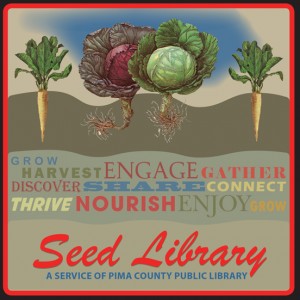Digging into the Planter Project
Smiles, salutations and the heavenly scent of books greet this writer on a summer Saturday morning at the Joel D. Valdez Main Library downtown. It is a half hour to opening and the staff is merrily chatting and organizing before their visitors arrive; light streams in through the southern facing floor-to-ceiling windows. The positivity and liveliness are contagious.
Today is a chat with Librarian Karen Greene who is much more than a librarian. Greene is a deeply involved community member (Mind Our Own Businesses, Tucson Spelling Bee, Book Bike, among other projects) and a visionary, with goals that range from short- and medium- to long-term, all shared with an inspiring lilt. We are sitting at a table in the library’s “café,” facing the plaza and the large planters we are meeting about.
“If I were queen,” she says, sweeping her arms in a gesture toward the Jácome Plaza and describing ideas for the half city-block space between the library and Pennington Street, with Stone Avenue and Church Avenue bordering the east and west ends. The field of vision fills with families enjoying a playground, a water splash park, a Kino Heritage Garden. Down the road, of course, if time and money can materialize…
“There are lots of cities with plazas that are vital to their downtown and we want Jácome Plaza to be vital to our downtown,” Greene explains. “I see a weekly event bookend: we have Meet Me at Maynard’s on Mondays, let’s have Meet Me at the Plaza on Fridays.”
Until the larger scope concepts can find sponsors or grants, there are more manageable projects on the horizon that will lead to refreshing the energy at Jácome Plaza. This summer, with the help of several community groups, the main library is gearing up to revitalize the plaza’s large, grey, concrete planters that flank the building’s southern end with new vegetation and dedicated attention.
 “The idea,” Greene says, “was another way to get the word out about the seed library and as a method to involve people in the planting process. The library is all about learning how to do stuff.”
“The idea,” Greene says, “was another way to get the word out about the seed library and as a method to involve people in the planting process. The library is all about learning how to do stuff.”
Library Associate and Seed Librarian Kelly Wilson adds that the project “will demonstrate the possibilities of container gardening (to community volunteers) and how to replicate it at their homes and feel empowered to garden.”
The local food and gardening movement has been gaining noticeable traction as more and more people are realizing the necessity of taking back the food supply chain from corporate powers. While gardening in arid lands can be intimidating, Tucson is blessed to have numerous resources available to the novice. The planter project is a great way for the uninitiated to get their hands dirty and minds expanded.
With the guidance of local organizations such as Aravaipa Heirlooms, Arizona Native Plant Society, Community Gardens of Tucson and others, interested Tucsonans can adopt a planter and work under the tutelage of mentors to help grow and maintain the vegetation.
“Creating the (planters’) designs are the community mentor groups,” Greene shares. Wilson adds to that, saying, “They decide what is going in the planters, they know what is doable in this kind of environment, and will share that information with the volunteers to maintain the planters.”
Also contributing to the effort is the Downtown Tucson Partnership, which will be supplying some soil plus man power to the watering scheduling, along with the University of Arizona’s Compost Cats offering compost.
The library will also provide workshops to the general public once “we get planting,” Greens says. The planting day and “Big Dig” for the volunteer and community groups is on September 28, as part of the library’s DIY Day.
As the interview wraps up, we walk over to the seed library. Potential plant life resides in little packets organized in an old card catalogue.
Greene pulls out a few examples, shows the bar code and explains: “You can check out six packets at a time. Once a month, we take those off of your account and you can get six more. The seeds are labeled easy, medium, advanced, which relates to the difficulty in saving the seeds.”
The idea is for borrowers to voluntarily return seeds from the plants they grow. “We want people to harvest seeds from their best plants; we’re also looking for stories,” Greens explicates. “If you don’t save them (the seeds), you don’t save them.”
The ultimate goal, Wilson says, is to have a “completely community supported seed library that will reflect what does work here and what doesn’t work here. We want community ownership of the seed library.”
It looks like it is working. Last month, Wilson said, one thousand seed packets were circulated and one-half of those were donated by local gardeners.
Informational meetings about the planter project are at the main library, 101 N. Stone Ave. on: Saturday, July 13, 8:30am-10am; Friday, July 16, noon-1pm; Saturday, August 10, 2pm-3:30pm; Friday, August 23, noon-1pm; Friday, September 6, noon-1pm. More details at Library.pima.gov (search Planter Project and seed library) or by calling the info line, 791-4010.
Category: Community, DOWNTOWN / UNIVERSITY / 4TH AVE




